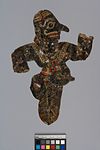tholu bommalata (Shadow Puppet)
About this object
History of use
Puppetry, particularly shadow puppets, is an ancient dramatic form in India mentioned in the Buddhist Jataka Tales of the 3rd century B.C.E. Nowadays modern forms of entertainment, such as the Hindi film industry, have rendered them extinct except for some rural areas in the states of Orissa, Kerala, Andhra Pradesh, and Tamil Nadu. The Andhra Pradesh/Karnataka shadow puppet tradition, compared to the few remaining troupes, are the most extensive and dramatic. Probably originally Maharashtran and maintained by dynasties, such as the Vijaynagars of the 13th and 14th centuries, it now survives as presented by Marathi-speaking puppeteers, commonly called Raoji. These are the largest in size of the Indian shadow puppets.
Iconographic meaning
Representation of a bhoot (bhut) figure, part of the contingent of Ravanna, the demon king of Sri Lanka. Bhuts are ghostly figures thought to be the wandering souls of people who died a violent death. The moustache, fat belly with protruding navel, long nose, and sharp teeth are recognizable aspects of this demonic type of figure. Three white horizontal marks on forehead are marks of Shiva, the tutelary god of Ravanna.
Physical description
A shadow puppet of leather cut out representing a fierce figure with a curled moustache, long teeth, a long nose, and a big belly with a protruding navel. Lower extremity tapers into single rounded stem. Hole is punched out of buttock that is edged with red dye. Flowers are patterned on arms, torso, and neck. Skin is black, and the flowers are white with red centres.
